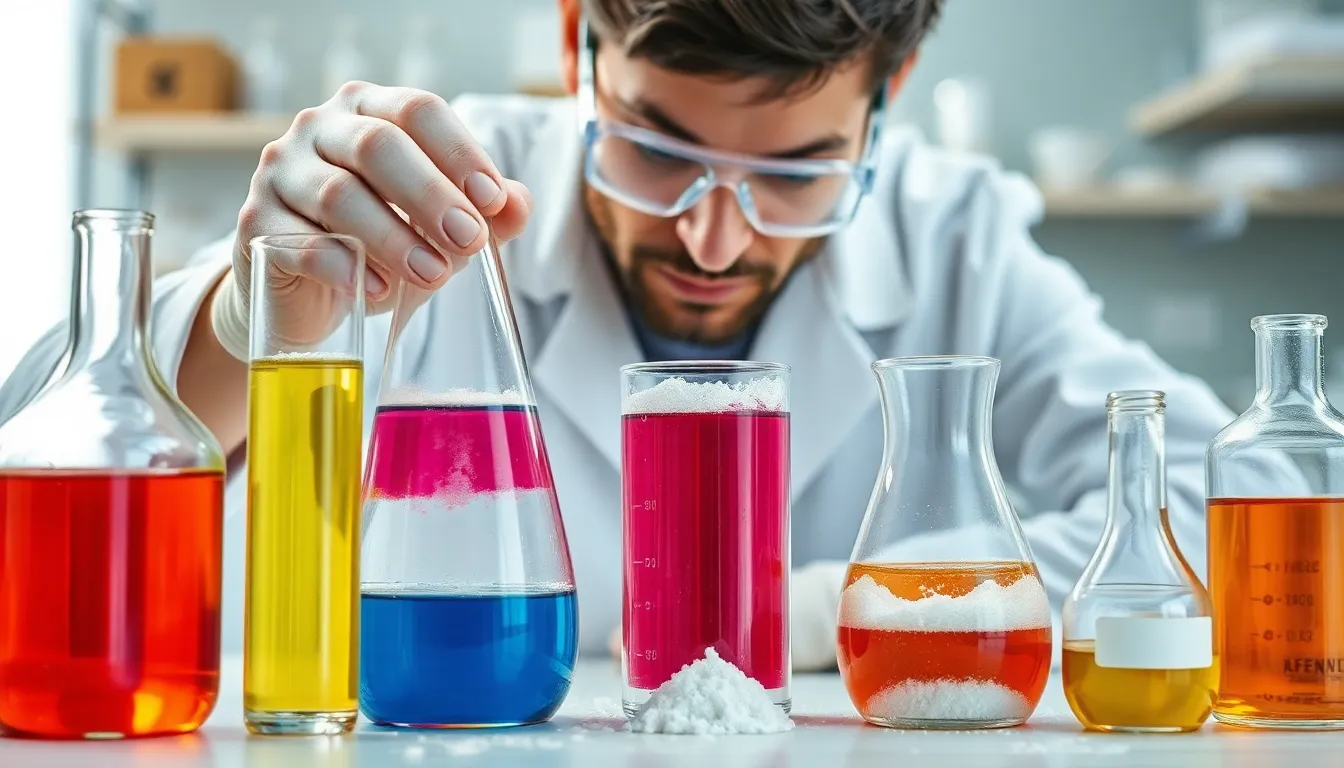Saponification might sound like a spell from a wizard’s handbook, but it’s actually the magical process of turning fats and oils into soap. Imagine your kitchen turning into a potion lab where greasy villains meet their bubbly demise. This age-old technique not only cleanses but also transforms everyday ingredients into luxurious bars of soap that could make even the grimiest hands feel pampered.
Table of Contents
ToggleUnderstanding Saponizacao
Saponization represents a chemical reaction that transforms fats and oils into soap and glycerin. This process occurs through a reaction between a strong alkali and triglycerides, which are the primary components of fats and oils. Sodium hydroxide is commonly used in solid soap production, while potassium hydroxide is preferred for liquid soap.
During the saponization process, triglycerides break down and create fatty acid salts. These salts form the structure of soap, providing its cleansing properties. Glycerin remains as a byproduct, contributing moisturizing effects in soap.
Temperature plays a significant role in saponization. Typically, reactions happen at 100°F to 140°F, ensuring proper mixing and effective chemical reactions. Stirring aids in combining ingredients, promoting uniform saponification throughout the mixture.
Saponization consists of a two-phase system with both aqueous and oil layers. Once the reaction completes, soap forms in the aqueous layer, while any unreacted oil stays in the oil layer. Homogeneous mixing leads to a smoother texture in the final product.
Monitoring the saponification process is crucial. pH levels indicate the reaction’s progress; an increase in pH generally implies that the reaction is nearing completion. After sufficient saponification, the soap mixture can be poured into molds and set to cure.
In various formulations, essential oils or fragrances are added to enhance the soap’s sensory qualities. Natural dyes may also be incorporated, allowing for aesthetic appeal in the final product. Saponization creates an opportunity for artisans and manufacturers to innovate with different ingredients.
The Chemistry Behind Saponizacao

Saponification involves intricate chemical processes that transform fats and oils into soap through the actions of fatty acids and alkalis.
The Role of Fatty Acids
Fatty acids play a crucial part in the saponification process. These compounds consist of long hydrocarbon chains that contribute to the soap’s structure. When triglycerides undergo saponification, fatty acids break down into their individual components. This breakdown results in fatty acid salts, which produce the soap’s cleansing effect. Various types of fatty acids can influence the characteristics of the soap. For example, lauric acid creates a hard, white soap, while oleic acid leads to a softer, moisturizing product. The combination of different fatty acids enables artisans to customize soap texture, lather, and conditioning properties.
The Importance of Alkalis
Alkalis are essential to the saponification process. Sodium hydroxide serves as the primary alkali for solid soap, while potassium hydroxide is preferred for liquid soap formulations. These strong bases initiate the chemical reaction needed to convert fatty acids into soap. By breaking down triglycerides, alkalis ensure effective saponification. Monitor pH levels throughout the process to confirm alkali efficiency and reaction completion. The right concentration of alkali affects the final soap quality significantly. Insufficient alkali leads to incomplete saponification, while excessive alkali results in harsh soap. Balancing alkali availability optimizes soap characteristics and the overall saponification quality.
Applications of Saponizacao
Saponification finds numerous applications across various sectors, prominently in soap production and industrial uses.
Soap Production
Soap production relies heavily on saponification. This process transforms oils and fats into soap, creating a cleansing agent with various properties. Artisans select specific fatty acids to influence the final product’s texture and lather. Essential oils and fragrances enhance the sensory experience, making soaps appealing to consumers. Solid soaps typically utilize sodium hydroxide while liquid soaps depend on potassium hydroxide. The curing process follows saponification, allowing soaps to harden and develop optimal qualities. A well-executed saponification process results in high-quality soaps, prized for their effectiveness and moisturizing benefits.
Industrial Uses
Industries utilize saponification for several applications beyond personal care products. Cleaning agents derived from saponified fats serve commercial and household purposes. Lubricants formed through this process find use in machinery and automotive sectors, ensuring smooth operations. Additionally, emulsifiers produced from saponification support various food and cosmetic industries by enhancing product stability. Detergents also benefit from saponification, with formulations tailored to meet specific cleaning needs. Overall, the versatility of saponification enhances efficiency and functionality across these diverse applications.
Benefits of Saponizacao
Saponification offers numerous benefits that extend beyond creating soap. Enhanced cleansing properties make saponified products effective in removing dirt and impurities from the skin. Often, consumers experience fresher and cleaner skin when using handcrafted soaps.
Moisturization occurs as glycerin, formed during saponification, acts as a humectant, drawing moisture to the skin. Many individuals find that saponified soaps leave their skin feeling hydrated rather than stripped of natural oils.
Customization is another significant advantage. Artisans can choose specific fatty acids for desired attributes, such as lather quality and hardness. Personal touches such as essential oils and colorings allow for unique, appealing soap varieties.
Health benefits also arise from using saponified products. Natural ingredients often replace synthetic or harsh components found in commercial soaps. With careful selection of fatty acids and additional ingredients, products become gentler on sensitive skin.
Sustainability plays a pivotal role in the discussion of saponification. Many soap makers source fats and oils from renewable resources, thereby minimizing environmental impact. Eco-friendly practices resonate with consumers seeking sustainable options in personal care.
Industrial applications further illustrate the versatility of saponification. Beyond personal care products, industries utilize saponified materials for cleaning agents, lubricants, and emulsifiers. Such versatility highlights the importance of saponification in enhancing product efficiency and performance across diverse sectors.
Overall, saponification serves as a foundation for numerous advantageous products. With benefits ranging from personalized soaps to eco-conscious formulations, its significance continues to grow within the industry.
Challenges and Considerations
Saponification presents several challenges that artisans and manufacturers encounter during soap production. Controlling temperatures is crucial; maintaining the reaction between 100°F and 140°F ensures proper mixing. Deviating from this range can lead to incomplete reactions or poor-quality soap.
Monitoring pH levels plays a significant role in achieving optimal results. pH must remain within a specific range for effective saponification, as imbalances can affect soap characteristics. Striking the right balance of alkali is essential for ensuring quality and consistency.
Ingredient selection also impacts outcomes. Using various fatty acids can yield different textures and lather qualities. Artisans need to choose fatty acids carefully; specific properties may align better with their desired soap attributes.
Saponification can create significant byproducts, primarily glycerin. While beneficial for moisturizing, excessive glycerin may complicate the curing process. Managing byproducts efficiently contributes to overall soap quality.
The curing process serves as a vital stage following saponification. Proper cure times facilitate texture development and scent retention. Insufficient curing may lead to soft or improperly hardened soap.
Understanding the environmental impact is increasingly relevant. Sourcing renewable fats and oils appeals to eco-conscious consumers. Prioritizing sustainable practices enhances brand reputation while meeting market demands.
Safety concerns cannot be overlooked. Handling strong alkalis like sodium hydroxide requires precautions to prevent injuries. Familiarizing oneself with safety protocols reduces risks associated with the saponification process.
Lastly, the creative aspect of adding fragrances and dyes can be both a challenge and an opportunity for differentiation. Balancing aesthetics with functionality remains critical in product development. Each consideration shapes the final product’s quality and appeal, reinforcing the importance of careful planning in the saponification journey.
Saponification is a remarkable process that transforms everyday fats and oils into luxurious soap. This chemical reaction not only creates effective cleansing agents but also opens the door for creativity in soap-making. By carefully selecting ingredients and monitoring conditions, artisans can produce high-quality soaps tailored to specific needs.
The benefits extend beyond personal care, influencing various industries that rely on saponification for efficient cleaning solutions. As more artisans embrace sustainable practices and natural ingredients, the appeal of saponified products continues to grow. The journey of saponification is not just about making soap; it’s about crafting a product that embodies care, creativity, and environmental consciousness.




